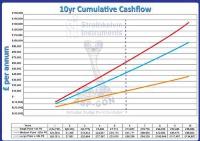 Add My Company
Add My Company
Sign In
Compliance is King But At What Cost?
27-10-2020

Compliance is King … but at What Cost?
For years Plant Managers sole purpose has been to ensure that their plant remains within it’s set compliance ranges, but at what cost? On one site we managed £380,000 or 26% worth of energy savings, 3.9GWh, 2995 tes CO2 reduction and improvement on Compliance. This was on a substantial sized site but these percentage savings can be replicated on most sites.
Strathkelvin Instruments have been trying to promote and educate Wastewater Treatment Plant Managers about their SCO2PE process for a number of years, which combines Strathkelvin’s sound biological science strategies, combined with their practical WWTP experience, giving them a unique understanding of the inner workings of Biological Wastewater Treatment encompassing a holistic approach to plant management.
This process has been evidenced through Strathkelvin’s work with numerous clients, incorporating many different types of WWTP setup, be that SBR, plug flow or even a crude hole in the ground. Strathkelvin have experienced it all.
Strathkelvin have further documented this evidence by publishing case studies, such as Kelda Water Services. With this SC02PE process, Strathkelvin have been able to reduce aeration costs by, on average, 25%. Reducing Utility Company Overall costs by between 5%-10%.
With the launch of our ASP-Con, Strathkelvin believes delivery of savings of up to 50% of aeration energy are a realistic possibility. The ASP-Con system also automatically monitors compliance indicators. In fact, there has been an increase in compliance and treatment capability on all of our clients’ sites through working closely with Strathkelvin.
Even with this compelling evidence, this SCO2PE process with it’s tried and tested science-based findings of how the bacterial health and well-being impacts on the optimal running of Wastewater Treatment plant’s processes, have been considered by unfortunately not actioned due to Plant Managers’ nervousness about practically exploring this process, for fear of a compliance failure. The true costs of ignoring this progress has been completely hidden. The responsibility for reducing the energy costs becomes a convoluted path of who is responsible and responsibility diminishes as this path meets the demands between plant, procurement, energy optimisation, finance etc.
At the 1st Water Scotland Conference, Scottish Water presented to the attendees that 20% of their overall costs were in aeration, when you think of this figure in relation to the huge employee costs, you realise just how huge this figure must be. Therefore SC02PE savings could equate to between 25% and 50% on aeration costs – equal to between 5%-10% of most Water Companies entire cost budget.
Strathkelvin’s technology and processes have moved from their lab-based instrument, the Strathtox, which was initially used to measure the impact of influent streams on the bacterial health, supplying the user with information how best to treat the plant. How well the bacteria will cope with the influent stream, how optimally to deliver them – at which dilution – can the stream be fed into the plant immediately or would it be better fed in gradually, being able to continually assess how the plant can acclimitise to each particular stream. Based on the survival of the fittest concept – which bacteria can survive and thrive to accommodate the treatment of the plant. As the Strathtox required lab based support this was seen as a blocker to it’s uptake. Even though the system is very straight forward.
Strathkelvin then progressed it’s R&D to the AS Bioscope. A hand-held device that could be inserted into anywhere in the plant and assessments could be made of the health of the bacteria, assessing whether the treatment process was complete or if the bacteria were experiencing issues. Again there was a reluctance in take-up as it required an understanding of the process and decision making ability to change this process. With the AS Bioscope studies we have been able to cut short the HRT, take lanes out – due to treatment being complete long before the waste has meandered through the plant. Stopping issues occurring with biological distress or splitting aeration requirements. Supported by Strathkelvin Instruments every step of the way.
Strathkelvin then took the next step in their R&D journey and moved to the in-situ model we are now working with, the ASP-Con, the Activated Sludge Plant Controller. This system can be inserted into the aeration lane, monitoring 20 parameters now, including DO, pH, temperature, being able to remotely do an MLSS or SVI without the requirement of a Plant operator, who’s precious time can be focused on dealing with other issues. More than one ASP-Con – one situated on the outlet as well as the aeration basis can now give feed forward/feedback control. Our instrument can sense a load coming in and when linked to the SCADA PLC system can control the rate of the blowers – similar to the automatic light – only comes on when required and switches off when no longer needed. This is securely backed up as the load is being measured on more than one parameter, therefore a belt and braces approach, further if customer requires back-up with control settings written into the SCADA system.
So Strathkelvin believe it’s time for Water Companies to take the next evolutionary step. We understand the importance of remaining within compliance, the SC02PE process can be instigated for huge savings, whilst support and improving compliance.
With our Strathtox Kelda study we managed £380,000 of savings, 3.9GWhr of energy and removed 2995 tes per annum of Kelda’s Carbon Footprint.
For more information on Compliance is King But At What Cost? talk to Strathkelvin Instruments Limited
Enquire Now
List your company on FindTheNeedle.

